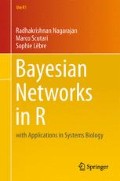Abstract
Most problems in Bayesian network theory have a computational complexity that, in the worst case, scales exponentially with the number of variables. It is polynomial even for sparse networks. Even though newer algorithms are designed to improve scalability, it is unfeasible to analyze data containing more than a few hundreds of variables. Parallel computing provides a way to address this problem by making better use of modern hardware.
In this chapter we will provide a brief overview of the history and the fundamental concepts of parallel computing, and we will examine their applications to Bayesian network learning and inference using the bnlearn package.
Access this chapter
Tax calculation will be finalised at checkout
Purchases are for personal use only
Notes
- 1.
Since version 2.14, the R base distribution includes a revised copy of snow in the parallel package.
References
Abramson B, Brown J, Edwards W, Murphy A, Winkler RL (1996) Hailfinder: a Bayesian system for forecasting severe weather. Int J Forecast 12(1):57–71
Borgelt C, Steinbrecher M, Krus R (2009) Graphical models: representations for learning, reasoning and data mining, 2nd edn. Wiley, New York
Chickering DM (1996) Learning Bayesian networks is NP-complete. In: Fisher D, Lenz H (eds) Learning from data: artificial intelligence and statistics V. Springer, New York, pp 121–130
Cooper GF (1990) The computational complexity of probabilistic inference using Bayesian belief networks. Artif Intell 42(2–3):393–405
Efron B, Tibshirani R (1993) An introduction to the bootstrap. Chapman & Hall, New York
Flynn MJ (1972) Some computer organizations and their effectiveness. IEEE Trans Comput 21(9):948–960
Friedman N, Goldszmidt M, Wyner A (1999a) Data analysis with Bayesian networks: a bootstrap approach. In: Proceedings of the 15th conference on uncertainty in artificial intelligence, pp 196–205
Friedman N, Pe’er D, Nachman I (1999b) Learning Bayesian network structure from massive datasets: the “Sparse Candidate” algorithm. In: Proceedings of 15th conference on uncertainty in artificial intelligence (UAI), Morgan Kaufmann, pp 206–215
Hastie T, Tibshirani R, Friedman J (2009) The elements of statistical learning: data mining, inference, and prediction, 2nd edn. Springer, New York
Koller D, Friedman N (2009) Probabilistic graphical models: principles and techniques. MIT Press, Cambridge
Li NM (2010) rsprng: R interface to SPRNG (Scalable Parallel Random Number Generators). R package version 1.0
Li NM, Rossini AJ (2010) rpvm: R interface to PVM (Parallel Virtual Machine). R package version 1.0-4
Margolin A, Nemenman I, Basso K, Wiggins C, Stolovitzky G, Favera R, Califano A (2006) ARACNE: an algorithm for the reconstruction of gene regulatory networks in a mammalian cellular context. BMC Bioinformatics 7(Suppl 1):S7
Meloni A, Ripoli A, Positano V, Landini L (2009) Improved learning of Bayesian networks in biomedicine. In: Proceedings of the 9th international conference on intelligent systems design and applications, IEEE Computer Society, pp 624–628
Rauber T, Rünger G (2010) Parallel programming for multicore and cluster systems. Springer, Berlin
Sachs K, Perez O, Pe’er D, Lauffenburger DA, Nolan GP (2005) Causal protein-signaling networks derived from multiparameter single-cell data. Science 308(5721):523–529
Schmidberger M, Morgan M, Eddelbuettel D, Yu H, Tierney L, Mansmann U (2009) State of the art in parallel computing with R. J Stat Softw 31(1):1–27
Tierney L, Rossini AJ, Li NM, Sevcikova H (2008) snow: simple network of workstations. R package version 0.3-3
Yu H (2010) Rmpi: Interface (Wrapper) to MPI (Message-Passing Interface). R package version 0.5-8
Zhang H (2004) The optimality of naive bayes. In: Proceedings of the 17th International Florida Artificial Intelligence Research Society Conference, AAAI Press, pp 562–567
Author information
Authors and Affiliations
Rights and permissions
Copyright information
© 2013 Springer Science+Business Media New York
About this chapter
Cite this chapter
Nagarajan, R., Scutari, M., Lèbre, S. (2013). Parallel Computing for Bayesian Networks. In: Bayesian Networks in R. Use R!, vol 48. Springer, New York, NY. https://doi.org/10.1007/978-1-4614-6446-4_5
Download citation
DOI: https://doi.org/10.1007/978-1-4614-6446-4_5
Published:
Publisher Name: Springer, New York, NY
Print ISBN: 978-1-4614-6445-7
Online ISBN: 978-1-4614-6446-4
eBook Packages: Mathematics and StatisticsMathematics and Statistics (R0)

